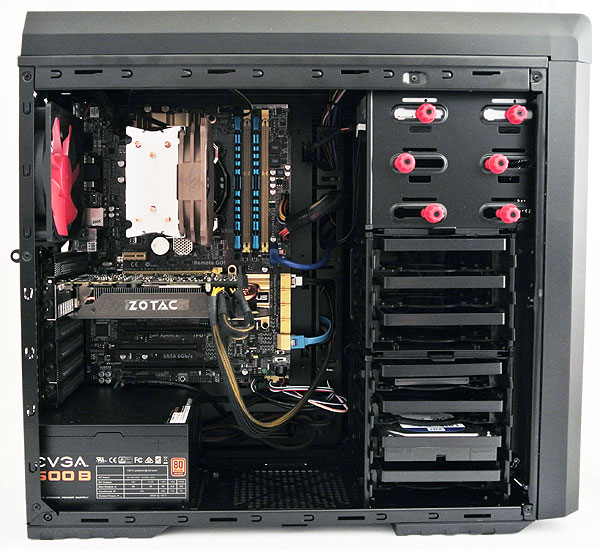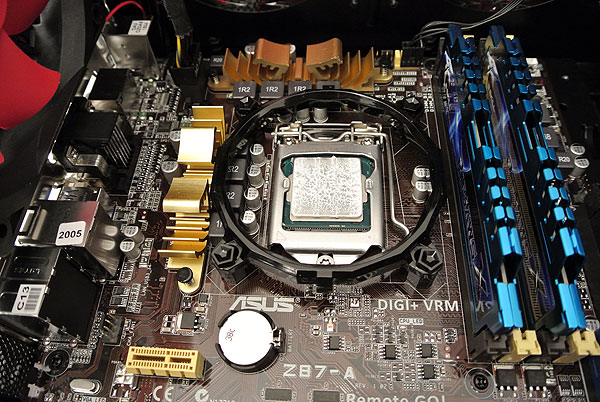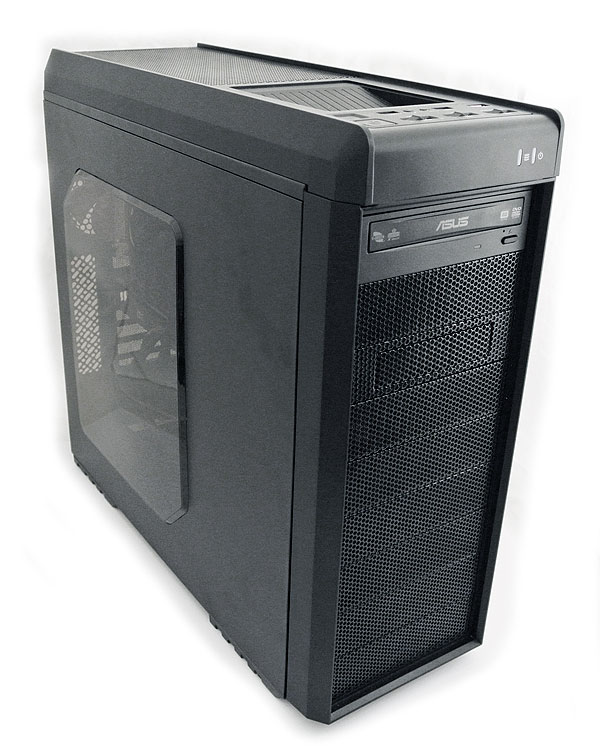System Builder Marathon Q4 2014: Mainstream Enthusiast PC
Building And Overclocking
DIYPC's Adventurer case is quite spacious and well appointed, and our build came together very easily. In the last few years I've really gotten the sense that case manufacturers have figured out the fundamentals of constructing an easy-to-assemble, spaceous enclosure, and I'm rarely disappointed anymore. Everything fit without incident, and if I have to complain it would be that the Adventurer's top removable fan grille mechanism is too easy to trigger when working with it, causing it to pop out until you pop it back in. That is nitpicking, but it's all I can grumble about.
After the initial assembly it became apparent that the ID Cooling SE-213 CPU cooler was not included in the shipment, and was sitting in our Culver city office. I went ahead and ran the benchmarks at stock settings by using a reference cooler I had lying around, and waited for the model I ordered to arrive in order to capture the temperature readings and overclocked results.
The ID-213 cooler showed up at my doorstep two days before publishing this article. Essentially this is a cooler built with native support for AMD's dual-point mounting system, with an adapter that adds a dual-point mounting bracket to Intel boards. It seems like an elegant solution, similar to aftermarket models that were available some years ago, and I installed it without incident.
...or so I thought. The cooler did require some pressure in order to seat it properly. At the time it didn't seem like any more than usual, but the system was hesitant to boot after the install. After four or five tries I was able to start it up and take the stock temperature measurements with the SE-213 cooler. Thinking I was out of the woods, I began the overclocking procedure. That's when it became apparent that the system would no-longer co-operate. It refused to boot despite a cleared CMOS no matter how many times I tried.
If you put together enough systems, sooner or later you'll run into a show stopping problem. I'm hesitant to lay blame on a specific component because I haven't even had time to properly diagnose the issue.
Ideally,I'll have time to fix the problem and run the overclock tests in the future, at which time I will update the article. I'll need to figure out what's faulty in order to make sure the system winner gets a working machine. Until then, though, we'll have to be content with the stock results alone.
Get Tom's Hardware's best news and in-depth reviews, straight to your inbox.
Current page: Building And Overclocking
Prev Page Memory, Hard Drives And Optical Storage Next Page How We TestedDon Woligroski was a former senior hardware editor for Tom's Hardware. He has covered a wide range of PC hardware topics, including CPUs, GPUs, system building, and emerging technologies.
-
envy14tpe You got the wrong GPU listed in the build. It is a 970 not 770. I'm referring to the Q4 build parts list. It should be the Zotac 970 4GB.Reply
Other than that. Build looks decent.
: Thanks for the heads up, fixed! :) -
rush21hit It's just perfect for 1k budget build. If I have such budget, I would gone to different casing though. Did you know Lian Li had just released their new casing that look sick awesome? They make it wall mountable too. I would go with that.Reply -
SessouXFX It's rare for reviewers to recommend a Zotac, At least from what I've seen, it's because just as things start to look good, Zotac make some questionable decisions with their cards. otherwise, they're quite affordable and are usually better than reference.Reply -
BoredSysAdmin "In this last system builder marathon of 2015"Reply
Did I just lost a whole year?
Derp, fixed! :P -
VaporX Okay so I looked over this build and honestly I was a bit disappointed because for the price you could have done better. Going to Newegg I got the following.Reply
i5 4690K with Gigabyte Z97MX Gaming, same ID cooler listed above, 8 Gig Crucial (1660) RAM, 240 Gig Crucial MX100, Thermaltake Core V21 Case, Thermaltake Smart 550 watt PSU, Sapphire Tri-X 290 and Windows 8.1 all for $1056.
So I lost the optical drive, no real lose there, some HD space (learn not to hoard) gained better onbaord sound, a large GPU performance bump and the speed advanateg of a pure SSD set.
IMO a much nicer gamer rig. -
envy14tpe Reply14906749 said:Okay so I looked over this build and honestly I was a bit disappointed because for the price you could have done better. Going to Newegg I got the following.
i5 4690K with Gigabyte Z97MX Gaming, same ID cooler listed above, 8 Gig Crucial (1660) RAM, 240 Gig Crucial MX100, Thermaltake Core V21 Case, Thermaltake Smart 550 watt PSU, Sapphire Tri-X 290 and Windows 8.1 all for $1056.
So I lost the optical drive, no real lose there, some HD space (learn not to hoard) gained better onbaord sound, a large GPU performance bump and the speed advanateg of a pure SSD set.
IMO a much nicer gamer rig.
They built this probably 3 weeks ago...so prices change. -
Scorpionking20 I got 2 of those exact gpus...sent them back due to hardware crashes and coil whine. Replaced them with 2 evga 970's and I couldn't be happier. Never again Zotac!Reply -
Onus I think the build is good. I'm going to guess that the budget cooler isn't going to support a high overclock, but that wouldn't matter to me, since I don't use +voltage to OC.Reply
I'm not going to quibble over the choice of Zotac. I've read mixed reviews of them. It isn't an obvious choice to me like MSI or Gigabyte, but it isn't one to avoid either like Diamond.
I'm disappointed that the OC numbers weren't included; maybe this build could have been presented "out of sequence" after troubleshooting?
I'd love to win this one; it is very much like something I'd build.



